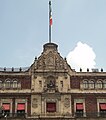Tezontle
Tezontle is a dark red lava rock that occurs mainly in the vicinity of Mexico City and from which many historical buildings in the center of the city ( centro storico ) were built.
material
The volcanic rock is porous, relatively light and easy to work; the red color suggests large amounts of iron oxide as an ingredient.
use
Already the Aztecs used the largely uncut material to build the temples and palaces of Tenochtitlán and Texcoco ; Most of the buildings were then covered with layers of stucco or plastered. After the Spanish conquest of Tenochtitlán under Hernán Cortés (1519–1521), the buildings regarded as pagan were demolished and the stones in the new colonial buildings - especially in the historic center of Mexico City - were reused and also plastered (e.g. the cathedral of Mexico City ).
In later times the Spaniards recognized the visual charm of the stones, worked them precisely and left the wall surfaces designed with it mostly unplastered; only the façades, corners, cornices as well as window and door frames were optically set off with hewn light sandstone .
Examples
Central elevation of the Palacio Nacional , Mexico City
Palacio de Cortés in Cuernavaca
Historic building made of Tezontle stone in Tlaquepaque , in the Mexican state of Jalisco






